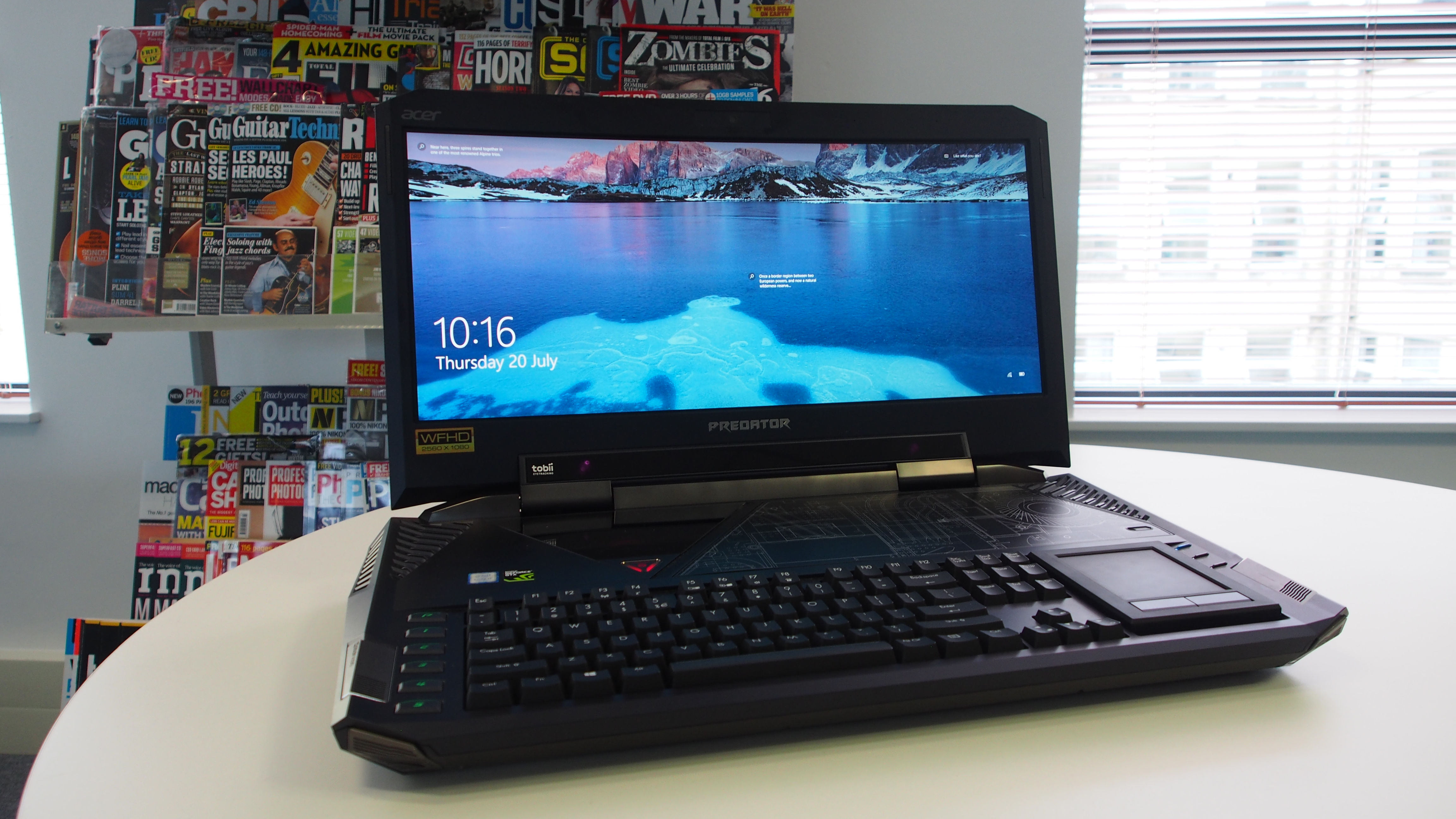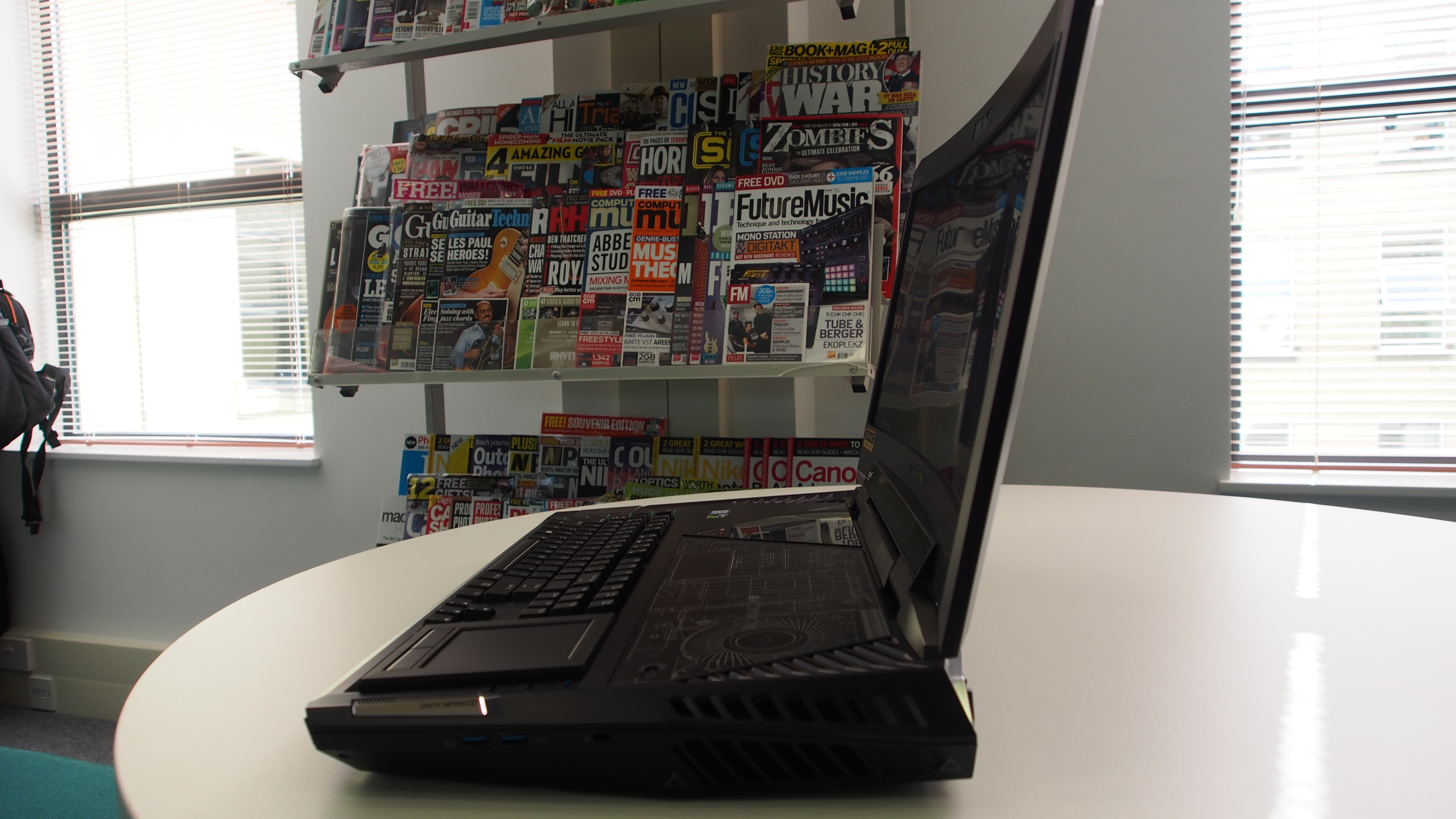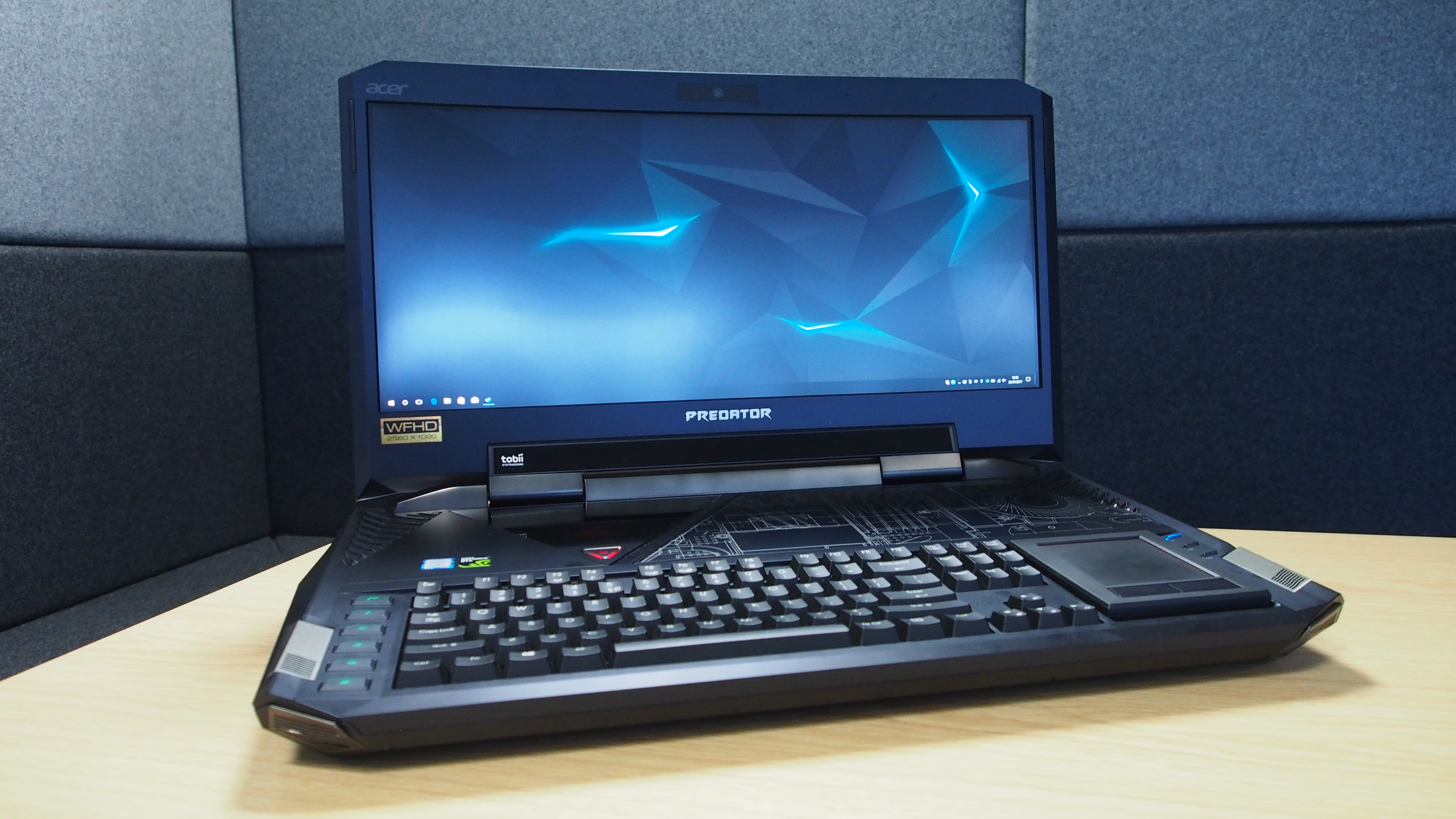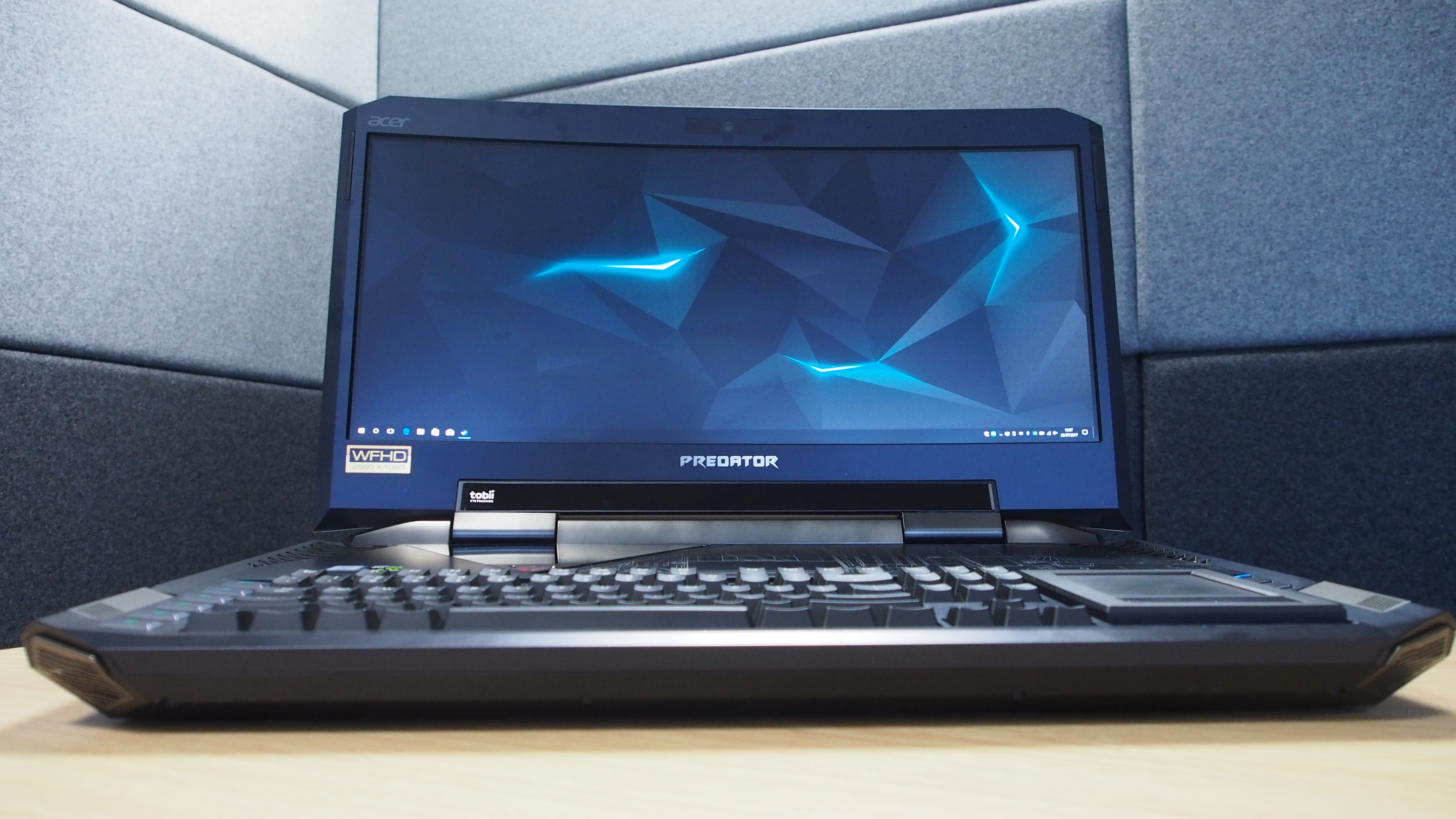Why you can trust TechRadar
Here’s how the Acer Predator 21 X performed in our suite of benchmark tests:
3DMark: Sky Diver: 33,962; Fire Strike: 20,545; Time Spy: 10,551
Cinebench CPU: 753 points; Graphics: 101 fps
GeekBench: 4,764 (single-core); 15,370 (multi-core)
PCMark 8 (Home Test): 3,927 points
PCMark 8 Battery Life: 1 hour and 16 minutes
Battery Life (TechRadar movie test): 1 hour and 28 minutes
Deus Ex: Mankind Divided (1080p, Ultra): 38 fps; (1080p, Low): 84 fps
GTA V (1080p, Ultra): 77 fps; (1080p, Low): 171 fps
Total War: Warhammer (1080p, Ultra): 103 fps; (1080p, Low): 246 fps
Of course, the biggest selling point of the Acer Predator 21 X is the crazy amount of power that this laptop contains. For many people, the specs list of the Predator 21 X reads as a veritable wishlist. This laptop contains some seriously powerful – and currently cutting-edge – components which are usually seen in monster gaming PCs, rather than laptops.
This includes an Intel Core i7 2820HK quad-core processor clocked at 2.90GHz, a 1TB hard drive, and two PCIe SSDs set up in RAID 0. So, while the two SSDs are already incredibly fast, setting them up in a RAID 0 array can further boost the disk speeds.
Graphical grunt comes courtesy of two Nvidia GTX 1080 graphics cards in SLI. Having two GPUs in one laptop is rare enough, and the GTX 1080 is one of the most powerful graphics cards around, though it has been superseded by the GTX 1080 Ti and the Nvidia Titan Xp.
While it is slightly disappointing that you don’t get the absolute latest GPUs, having two GTX 1080s in SLI is still mighty impressive for a laptop – and they are overclocked by Acer to eke out every ounce of power from them.

While these are impressive specs so far, Acer has really pushed out the boat when it comes to RAM, including 64GB of DDR4 memory at 2,400MHz. It’s here that a bit of restraint may not have been a bad thing – 64GB of RAM is certainly impressive, but it’s also overkill if you’re only using the Predator 21 X as a gaming device.
However, thanks to the incredible graphics power, combined with the RAM, SSDs and astonishing display, the Predator 21 X could be an excellent mobile workstation for people who use graphic-intensive tools – such as digital artists and video editors. It’s actually here that the price – and power – of the Acer Predator 21 X actually begins to make sense.

So, how does the Acer Predator 21 X perform? As you’d expect (and can see from our benchmark results), the Predator 21 X performs extremely well. At the standard 1080p resolution, it hit 38 frames per second for the incredibly taxing Deus Ex: Mankind Divided benchmark on Ultra settings. While it doesn’t hit that magical 60 frames per second (fps) on Ultra, it still blows its closest competitor, the Asus ROG Zephyrus GX501 out of the water, as it managed 18 fps in the same tests.
However, it’s important to note that while we say ‘closest competitor’, the Asus ROG Zephyrus GX501 costs $2,699 or AU$3,659 (about £2,105), which is still less than a third of the price of the Acer Predator 21 X.
While the Acer Predator 21 X comes with two GTX 1080 graphics cards in SLI, the Asus ROG Zephyrus GX501 ‘only’ comes with one. Another thing to note is that, while we ran the benchmarks in 1,920 x 1,080 resolution – for a better comparison with other laptops – you’ll actually be running games in 2,560 x 1,080 resolution to take advantage of the Predator 21 X’s ultra-wide screen.
In that resolution, the frame rates in the Deus Ex benchmark on ultra drop to 18.9 frames per second – which will be unplayable for many people. This will be disappointing for anyone who thinks by paying $9,000 for a laptop will allow them to play the latest games at ultra graphical settings, and with high resolutions with framerates to match.
To get better results, you can turn on GPU and CPU overclocking using the Acer Predator software. This makes both components work harder – and the software makes turning this feature on safe and easy. With GPU overclocking set to ‘Turbo’, the Deus Ex benchmark at 2,560 x 1,080 resolution brought back a marginally better average of 21 fps, with highs of 28 fps. That’s still not quite a rock-solid 30 fps, though.
We’d like to note here that the bunded Acer Predator software is excellent, making it easy not just to overclock your components, but also set up the macro buttons on the keyboard and configure the LED lighting that decorates the Acer Predator 21 X.

Things were better with the less graphically-intensive real time strategy game Total War: Warhammer, which typically taxes the CPU a bit more. Here, the Acer Predator 21 X scores an excellent 103 fps on Ultra at 1080p, with it dropping to a still-respectable 94 fps at 2,560 x 1,080.
Amongst titans
So, there’s no doubt that the Acer Predator 21 X is an incredibly powerful laptop, and one with no peers – unless you start looking at desktop PCs.
And, that is the Acer Predator 21 X’s main problem – its high price tag and the power of its components means it actually competes with gaming desktops. It’s more portable than a desktop PC, but again, between its weight and need for two power supplies, it’s not actually that much more portable.
And, when you compare it to a desktop gaming machine, both its price and its power become almost indefensible. For a fraction of the cost, you could buy (or build) a gaming rig that equals – or beats – the Acer Predator 21X.
For example, last year’s HP Omen X costs $2,599 (£2,499, around AU$4100) and matches or beats the Acer Predator 21 X in the benchmark tests. This is with only a single GTX 1080 and 16GB of RAM – if you wanted to add a second GTX 1080 or up the RAM later, you can easily do that, and the price would still be drastically lower than that of the Acer Predator 21 X.
If you’re a serious gamer who is concerned about getting as much power as possible, you’ll need to think carefully about whether the limited portability of the Acer Predator 21 X is worth an extra $4,000. Or, you could put your money in a less powerful, but far more slim and light, gaming laptop. Thanks to Nvidia’s Max Q technology, we’re now seeing some seriously slimline gaming laptops that balance gorgeous designs with powerful components.
But, enough about benchmarks, how does it actually feel to play games on the Acer Predator 21 X? The answer is, thankfully, very good – especially if you tweak a few graphical settings to make sure it’s running as smoothly as possible. The ultra-wide screen is a cool benefit, but while 21 inches is very large for a laptop screen, it’s still not big enough to really fill your field of vision and completely immerse you.
Meanwhile, the Tobii eye tracking technology does a good job, and we tried it with a few compatible games, including Deus Ex: Mankind Divided. Even in a busy room with bright lights, the eye tracking hardware accurately detected where we were looking and moved the camera accordingly. This worked best in games when you’re standing still and looking – or games in which you are sitting in a cockpit.
Fan noise was kept to a minimum – even when overclocking the components – a welcome and impressive feat. The size of the Acer Predator 21X ’s body, in conjunction with the large number of heat pipes and silent design of some of the fans, helps keep the laptop cool and quiet while running intensive games.
The screen is a joy to watch movies on – as the colors and detail are very impressive, while the 21:9 aspect ratio eliminates the black bars at the top and bottom of the screen. Of course, for content that isn’t filmed in that aspect ratio, such as 16:9 widescreen TV shows, you’ll get black bars down the left and right sides of the screen, if you watch it in full screen.
As you’d expect with a laptop of this power, Windows 10 on the whole feels fast and snappy – though we were a bit disappointed with boot-up times considering the speeds of the SSD.
From cold, Windows 10 took 37 seconds to fully load. This isn’t bad at all, but not quite the ‘blink and you’ll miss it’ boot up time promised by Acer. Games also took a while to load sometimes, but on the whole we were pleased with the performance.

Battery life
With a laptop of this size, with powerful and often overclocked components, a huge ultra-wide screen, and the need for two large power adaptors, it’s probably little surprise to learn that the Acer Predator 21 X’s battery life is incredibly slight.
In our battery life benchmark, where we run a looped high definition video file, the battery lasted just 1 hour and 28 minutes. The PCMark 8 battery life benchmark, which mimics standard use, such as browsing websites, making video calls and a bit of light gaming, was even worse; lasting just one hour and 16 minutes.
And, if you’re playing games, the battery life depletes even faster. Of course, with great power comes great power consumption, but the very short life of the Acer Predator 21 X’s 8-cell, 6,000 mAh essentially dismisses any notion that this is a portable laptop.
This again raises the question of why you’d pay over the odds for this device. It’s no more powerful than a decent gaming desktop PC, and not that much more portable. But it’s a heck of a lot more expensive.
We liked
There’s no denying that this is the most powerful gaming laptop ever made, and we love the ambition of the device. Having two GTX 1080 graphics cards, loads of storage and 64GB of RAM in a single laptop is ridiculous – in a good way.
The 21-inch curved ultra-wide screen is also impressive, and while we had the laptop on our desk, we had plenty of people coming over and giving it admiring glances. It’s certainly a talking point, and whoever owns the Predator 21 X is certainly making a statement.
We didn’t like
You probably already know what we’re going to say: the price – £9,000 ($8,999.99, around AU$15,120) is an absolutely huge price tag. While it will get you the most powerful gaming laptop ever built, this is a price that will be out of most people’s reach.
For that price you could buy an equally-powerful desktop gaming PC, along with a not-quite-as-powerful, but still pretty darn impressive, gaming laptop and have a grand or so cash left to spare. This is money that could buy you a car, or go some way to putting down a deposit on a house.
We’re also not hugely convinced with the design – in a world where Max Q laptops are proving that gaming laptops can be slim and sexy, the Acer Predator 21 X looks a bit… well, ugly.
And, while its power makes it a good choice for a mobile workstation, its ‘extreme gamer’ aesthetics undermine this a bit.

Final verdict
So, what can we say about this £9,000 ($8,999.99, around AU$15,120) gaming laptop? If you have that sort of money to spend on a machine, and you want the most powerful gaming laptop ever made, then there really is no other option.
Acer obviously isn’t expecting to sell thousands of these devices, but there are enthusiasts out there that will want the very best no matter what the cost, and they won’t be disappointed with the Acer Predator 21 X.
A lot of thought and consideration has been put into this laptop, making it the ultimate premium gaming machine. This is backed up with a level of customer service for Acer Predator 21 X owners that goes beyond the usual offerings. If you buy this laptop, you will certainly feel like a member of an elite club.
But, what about the rest of us who could not even consider spending this much money on a laptop? Well, there’s still a lot to admire here, especially if you consider – as we suggested at the start of this review – the Acer Predator 21 X as a proof-of-concept design.
Looking at it this way, it shows how far laptop technology has come – and what they can achieve. Acer went out of its way to create a no-holds-barred, uber powerful gaming laptop, and it has certainly achieved that. Even if we could never afford it, there’s a lot to respect.

Matt is TechRadar's Managing Editor for Core Tech, looking after computing and mobile technology. Having written for a number of publications such as PC Plus, PC Format, T3 and Linux Format, there's no aspect of technology that Matt isn't passionate about, especially computing and PC gaming. He’s personally reviewed and used most of the laptops in our best laptops guide - and since joining TechRadar in 2014, he's reviewed over 250 laptops and computing accessories personally.
